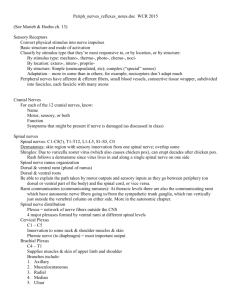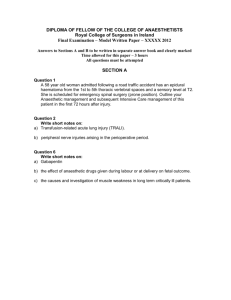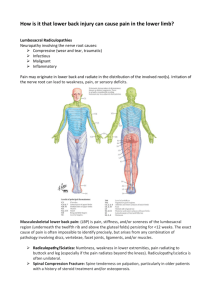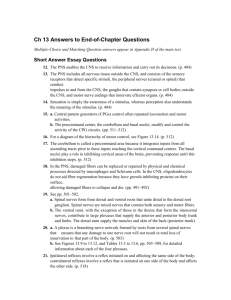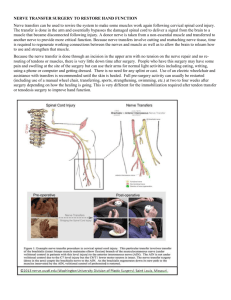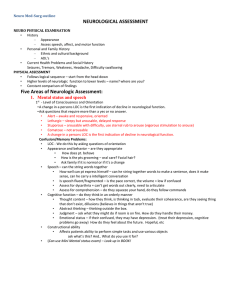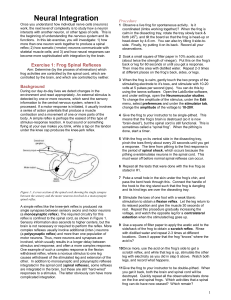Evaluation
advertisement
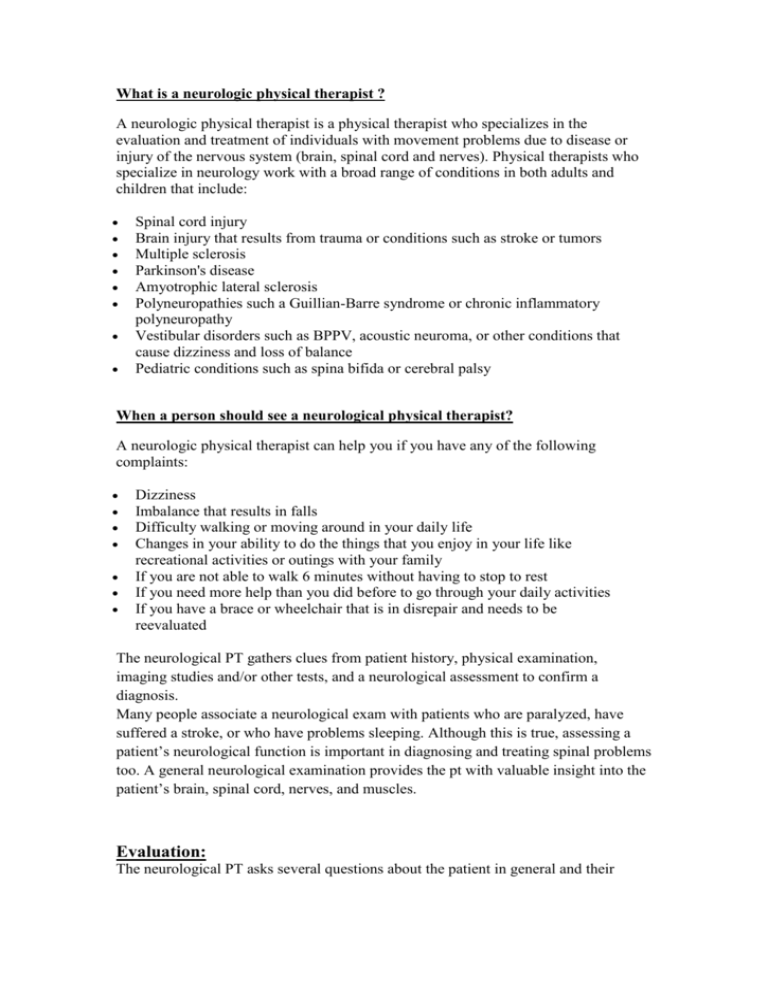
What is a neurologic physical therapist ? A neurologic physical therapist is a physical therapist who specializes in the evaluation and treatment of individuals with movement problems due to disease or injury of the nervous system (brain, spinal cord and nerves). Physical therapists who specialize in neurology work with a broad range of conditions in both adults and children that include: Spinal cord injury Brain injury that results from trauma or conditions such as stroke or tumors Multiple sclerosis Parkinson's disease Amyotrophic lateral sclerosis Polyneuropathies such a Guillian-Barre syndrome or chronic inflammatory polyneuropathy Vestibular disorders such as BPPV, acoustic neuroma, or other conditions that cause dizziness and loss of balance Pediatric conditions such as spina bifida or cerebral palsy When a person should see a neurological physical therapist? A neurologic physical therapist can help you if you have any of the following complaints: Dizziness Imbalance that results in falls Difficulty walking or moving around in your daily life Changes in your ability to do the things that you enjoy in your life like recreational activities or outings with your family If you are not able to walk 6 minutes without having to stop to rest If you need more help than you did before to go through your daily activities If you have a brace or wheelchair that is in disrepair and needs to be reevaluated The neurological PT gathers clues from patient history, physical examination, imaging studies and/or other tests, and a neurological assessment to confirm a diagnosis. Many people associate a neurological exam with patients who are paralyzed, have suffered a stroke, or who have problems sleeping. Although this is true, assessing a patient’s neurological function is important in diagnosing and treating spinal problems too. A general neurological examination provides the pt with valuable insight into the patient’s brain, spinal cord, nerves, and muscles. Evaluation: The neurological PT asks several questions about the patient in general and their symptoms. The list below is not all-inclusive. Depending on the patient and their symptoms, additional questions may be posed. Have you noticed weakness in your arms or legs? Does the weakness come and go or is it consistent? Do you experience muscle twitching? Do you have problems walking? What kind of problems? When do you have problems walking? Climbing stairs? Walking downhill? Do you experience cramps in your legs? Do you have any numbness, tingling, or pain in your back or extremities? Does changing position relieve your symptoms? What makes your symptoms worse? Do you have bowel or bladder problems? Gait and Balance: Walking, or gait, simply means the way a person walks: rhythmical pattern and speed. Walking is a complex process involving different reflexes stimulated by the nervous system and the person’s awareness of where they are in space (termed ‘proprioception’), which is important for balance. The NPT may ask the patient to walk across the room, turn and come back, walk heel to toe, on their toes and heels, hop in place on each foot, and/or rise from a sitting position. The NPT observes any listing, erratic movement, or loss of rhythm. These movements may also indicate weakness and difficulty with balance. Sensory: Numbness, tingling, burning, and pain are abnormal feelings that may be felt in the back and/or extremities. Sometimes these symptoms radiate from one area into another. Sciatica is a good example of pain that can radiate into an extremity (leg). Nerves originate from the spinal cord and divide into sensory and motor nerves. The sensory nerve gives sensation to the skin (dermatomes). The dermatomal patterns appear similar to a map on the body. For example, dermatomes on the trunk of the body correspond to the thoracic spinal nerve roots, those on the arms to the cervical spine nerve roots, and legs to the lumbar spinal nerve roots. Dermatome Location Corresponding Spinal Level Shoulders C4, C5 Inner and outer forearms C6 and T1 Thumbs and little fingers C6, C7, C8 Front of both thighs L2 Middle and side of both calves L4, L5 Little toes S1 The NPT may use a piece of cotton, a swab, pin or paperclip to test symmetrical feeling in the arms and legs. Abnormal responses may be indicative of a nerve root problem. Deep Tendon Reflexes: Most people have experienced tapping their knees with a rubber hammer. The normal response is a ‘knee jerk’. This is an example of a reflex, which is an involuntary muscular response elicited by the rubber hammer tapping the associated tendon. When reflex responses are absent this could be a clue that the spinal cord, nerve root, peripheral nerve, or muscle has been damaged. When reflex response is abnormal, it may be due to the disruption of the sensory (feeling) or motor (movement) nerves or both. To determine where the neural problem may be, the NPT tests reflexes in different parts of the body. See the following examples in the chart below. Area Tested for Reflex Biceps (upper arm) Distal Radius (forearm) Triceps (elbow) Abdominal Quadriceps/Patellar (thigh, knee) Ankle Corresponding Spinal Level C5-C6 (Cervical) C6-C7 C7 T8, T9, T10, T11, T12 (Thoracic) L3, L4 (Lumbar) S1 (Sacral) Muscle Strength and Tone: Measuring muscle strength and tone is another way to determine if nerve deficit exists. To evaluate muscle strength the patient may be asked to step up on a stool, stand on their heels then the toes, hop in place, perform knee bends, and grip an item in each hand. Muscle strength is graded and recorded in the patient’s chart. Grade Zero 1 2 3 4 5 Muscle Activity No movement Trace of muscle contraction Active movement without gravity Active movement against gravity Active movement against gravity/resistance Normal The NPT tests muscle tone by passively flexing and extending the arms and legs. Normal muscle tone elicits slight resistance to passive motion. Other movements test for proximal (trunk) and distal (distant) weakness. Muscle symmetry is also observed. Neurological Tests: If warranted, the NPT may order specific neurological studies such as a Nerve Conduction Study (NCS) or Electromyogram (EMG). These tests measure nerve performance. Imaging Studies: MRI and/or CT scans of the spine can be ordered to help the NPT make the correct diagnosis.



